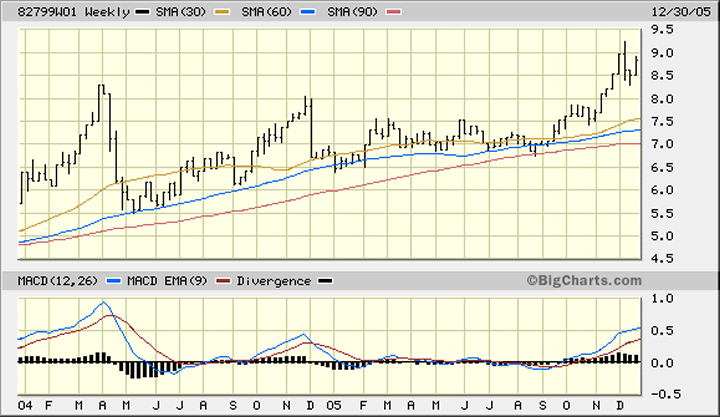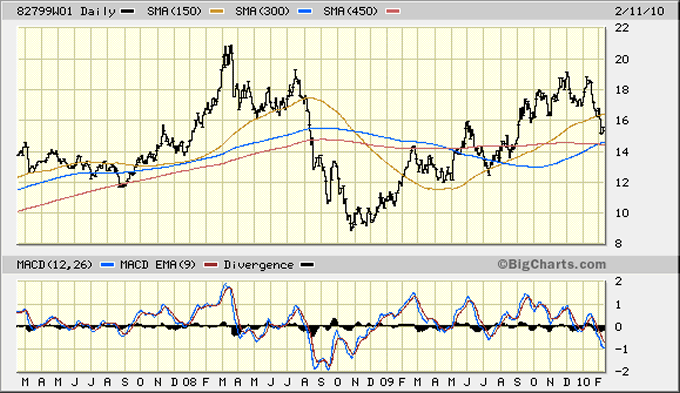Will Silver Outperform Gold in 2010?
Commodities / Gold and Silver 2010 Feb 12, 2010 - 12:09 PM GMTBy: Clif_Droke
 In a recent issue of Barron’s addressed the question of silver possibly having another outperformance in the coming year. The article asks, “Will the poor man’s gold shine in 2010?” The opinion piece (“Gold Isn’t All That Glitters,” by Allen Sykora) drew attention to the other white metals, platinum and palladium, and made a case for a strong recovery in global demand for these metals along with silver in the year ahead.
In a recent issue of Barron’s addressed the question of silver possibly having another outperformance in the coming year. The article asks, “Will the poor man’s gold shine in 2010?” The opinion piece (“Gold Isn’t All That Glitters,” by Allen Sykora) drew attention to the other white metals, platinum and palladium, and made a case for a strong recovery in global demand for these metals along with silver in the year ahead.
The forecast for a good year for the white metals is predicated on strong continued overseas demand for the metals for industrial applications and depends largely on the global market recovery that began last year continuing in 2010. The market action of the last few weeks has already called this assumption into question somewhat and much depends on an improvement in the intermediate-term internal momentum pattern for silver. The article serves more as a warning against the dangers of linear extrapolation than a call for a raging non-stop bull market.
The Barron’s article also made reference to the gold/silver ratio as being one reason for expecting an outperformance in silver this year. One should always be skeptical of basing forecasts on ratios, however. A number of analysts made some bold predictions for the gold and silver prices using ratios just prior to the market collapse of July-November 2008, providing us with a classic example of how ratios can often prove misleading. Inter-market ratios work well when market internals are in synch on the upside in the midst of a bull market move, but when the market’s momentum and cyclical configurations aren’t supportive of a continued uptrend, ratio-based forecasts tend to be of little value.
Another point that can be drawn from the Barron’s article is that technical analysis is primarily a short-term forecasting tool. One must be very careful of making longer-term (read year-ahead) projections using technical analysis. For longer-term forecasting a combination of cycles, fundamental analysis and some old-fashioned good luck is of paramount importance.
The Barron’s article also bases its bullish silver forecast on improving car sales in China and internationally, as platinum and palladium are used for catalytic converters in automobiles. Basing a bullish silver forecast on a linear extrapolation of car sales trends is rife with potential pitfalls. China’s stock market performance in recent months has been less than stellar and China’s pursuance of higher interest rates starting last August is a concern for investors in that country. If China continues to pursue a tight money policy it could bode ill for its economic outlook.
The Barron’s article asserted that “Silver, platinum and palladium all outperformed gold in 2009, and they are likely to repeat that feat this year, analysts say.” The article went on to point out that gold rose 24% in 2009 versus a 49% gain in silver, a 56% rise in platinum and a 117% increase in palladium. These are impressive statistics to be sure, and there’s no denying the fundamentals are bullish for the secular (longer-term) outlook for silver. But again one must be careful of basing short- and intermediate-term forecasts on current trend projections. Linear extrapolation can be dangerous and just because the white metals had a blow-out year in 2010 doesn’t necessarily guarantee that that performance will repeat in the year ahead. Better to rely on the internal momentum and other technical indicators and follow the market’s path of least resistance one step at a time instead of “holding and hoping” that last year’s trend continues without a hitch along the way.
From a technical standpoint one of the things we can notice about silver’s price is that when the dominant long-term 30/60/90-week moving averages are in synch on the upside, corrections within the secular uptrend have always been reversed upon coming into contact with one or more of these three trend lines. For instance, there were three corrections for the silver price in 2005. The first two of these found support above the rising 60-week MA, the third one found support above the 90-week MA.

The only time the key long-term moving averages are of no benefit as benchmark support levels is during times of serious market panic when support means little and even long-term supports are sliced through like a hot knife through butter. This was assuredly the case during the credit crisis panic of August-October 2008.

Institutional fund managers look at these benchmark moving averages as important levels of potential support and use these as buying opportunities after significant corrections in the silver price. As long as internal market conditions are supportive of a market recovery, tests of the long-term trend lines are apt to elicit buying interest from the institutional and professional element, which is why it’s important to always keep an eye on these moving averages following a sharp decline in the silver price.
An important intermediate-term cycle is currently in the process of bottoming and now is the time to look closely at silver. If silver confirms a bottom above the point where the 60-week and 90-week moving averages converge in the daily chart as shown above, we should have a good base from which a recovery can begin. The internal momentum indicators will confirm the shift of trend once the cycle has bottomed and will tell us what to expect in terms of upside potential in the next recovery phase.
Silver Trading Techniques
With the precious metals long-term bull market well underway, many independent traders and investors are looking for ways to capitalize on short-term and interim moves in the metals. Realizing that the long-term “buy and hold” approach isn’t always the best, many are seeking a more disciplined, technical approach for realizing gains in the market for metals and the PM mining shares.
It’s for that reason that I wrote “Silver Trading Techniques” back in 2005. My goal in writing this book was to provide traders with some reliable trading indicators for anticipating and capturing meaningful moves in the price for silver and the silver mining shares. Included in this guide are rules for using the best moving averages when trading silver stocks, how to spot a turnaround in the silver stocks before it happens (best-kept secret!), how to tell when a silver stock has topped and which moving average crossovers work and which don't . Also explained are the best technical indicators for capturing profitable swings in silver and silver stocks and how to apply them.
You won't find these techniques in a copy of Edward's & Magee's book on technical analysis or anywhere else. These reliable "tricks of the trade" are available to you in Silver Trading Techniques. Click here to order: http://www.clifdroke.com/books/book01.mgi
All orders for the book will receive an additional copy of the recently published, “Gold Stock Trading Techniques,” which contains reliable strategies for short-term technical trading in the gold mining shares with an emphasis on safety and capital preservation.
By Clif Droke
www.clifdroke.com
Clif Droke is the editor of the daily Gold & Silver Stock Report. Published daily since 2002, the report provides forecasts and analysis of the leading gold, silver, uranium and energy stocks from a short-term technical standpoint. He is also the author of numerous books, including 'How to Read Chart Patterns for Greater Profits.' For more information visit www.clifdroke.com
Clif Droke Archive |
© 2005-2022 http://www.MarketOracle.co.uk - The Market Oracle is a FREE Daily Financial Markets Analysis & Forecasting online publication.



